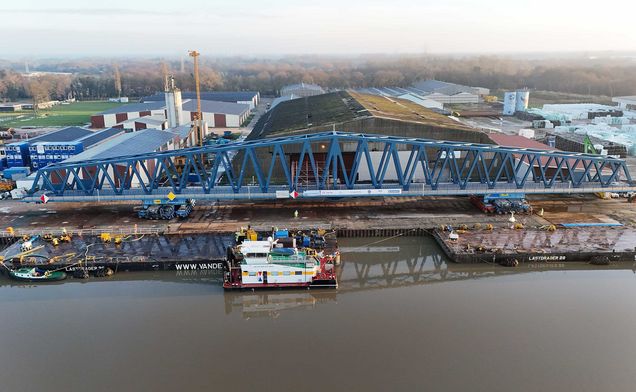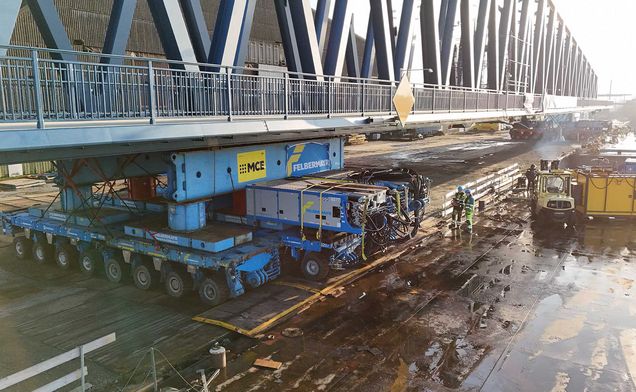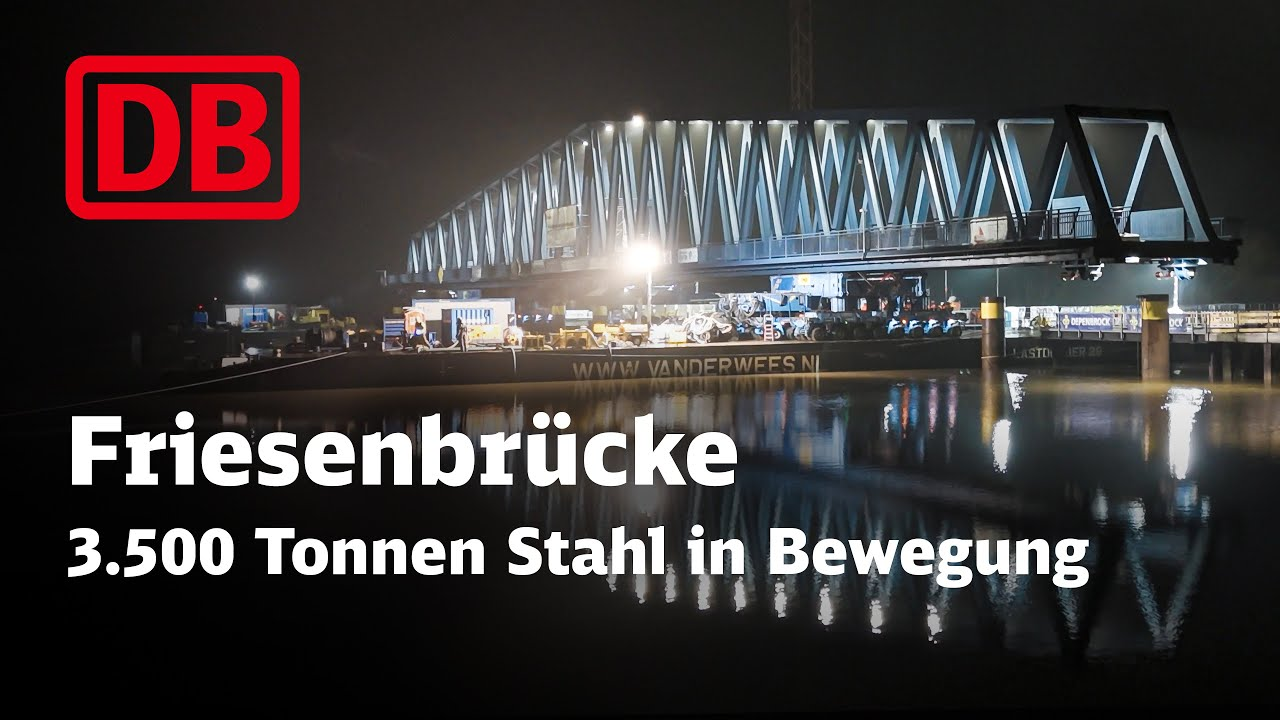Colossal: Engineered Solutions positions Europe's largest lifting swing bridge
February 17, 2025 | Lucia Reinsprecht
The region on the border with the Netherlands has been waiting a long time for this moment: After the old Friesenbrücke bridge was irreparably damaged by a freighter in December 2015, travellers had to switch to buses and rail replacement services. So far: Thanks to precise planning, the efficient use of heavy-duty equipment and close coordination between the authorities involved and Deutsche Bahn, the new bridge was successfully handed over ahead of the planned project completion date.
Bridge transport in sections
From the beginning: A lift-and-turn construction was planned to make the bridge equally passable for ship and land traffic. This consists of two foreland bridges and a movable centre section. The centrepiece of the bridge is a rotating pillar with the mechanical equipment in the riverbed, on which the 145-metre-long central bridge section rests. In June, the Engineered Solutions team started work on the first 120 metre long and 1250 tonne bridge section. "This consisted of individual parts fourteen metres wide and thirty metres long, which we first loaded onto two eight-axle SPMTs at the assembly site and then transported to the quay," says Roel Aarts, project manager at Engineered Solutions, describing the first steps. The bridge sections were each loaded individually onto a floating crane for the approximately seven-kilometre transport from the assembly site in Papenburg across the Ems to the final location. "At the installation site, these were then loaded onto a double ten-axle SPMT, securely lashed down and then driven to the foundations," says Aarts. There they were set down on the abutments with millimetre precision. Once the four bridge sections had been positioned and aligned, they were welded together.
Numerous plans
The second 75 metre long bridge section required even more precise coordination. After pre-assembly, the bridge colossus was first loaded onto a 36-axle SPMT. However, before the 700-tonne heavyweight could be moved onto a pontoon for onward transport across the Ems, a further point had to be addressed in the planning: In order to manoeuvre the colossus safely between the buildings at the port to the quay, a hall had to be demolished.
Set down with high water
But it wasn't just the transport on land that required months of precise advance planning - the Engineered Solutions team also had to take the tide of the river into account for the transport on the Ems: "Firstly, we positioned the pontoon together with the SPMT and bridge behind the piles for the guide gear. On the day of floating in, we turned the bridge 90 degrees on the pontoon," says Aarts, explaining the highly demanding process. We had to wait until the Ems had reached high-water in order to reach sufficient height for the float-in. The team had a time window of exactly one hour to align the bridge over the foundation along the vertical beam. Due to the naturally falling water level, the second section of the Friesenbrücke bridge could be transferred to the already installed step press and lowered onto the prepared mountings.
Ems dammed up
The highlight of the project was the positioning of the 1800 tonne swing bridge. This was initially stacked up to around four metres high in order to "shoulder" the two ends with two SPMTs with 36 axles each. The 145 metre long centrepiece of the Friesenbrücke bridge was then rolled onto two pontoons for final positioning. However, before the movable centrepiece of the bridge could be floated into place, adverse weather conditions delayed the spectacular showdown for the prestigious project: "During a critical phase, we had wind speeds of up to 22 metres per second," explains Aarts: "Under these conditions, the loaded pontoon would have reached a transverse inclination of 5 degrees, which is why we left the bridge on the SPMTs for the time being. Normally, the water level of the Ems fluctuates by three metres between high and low tide, with current speeds of up to 2.5 metres per second - too much for the floating-in process, during which the 1800-tonne bridge has to be positioned with millimetre precision. Therefore, a special damming of the Ems was requested for the final placement, which enabled a stable water level for 24 hours.
The final rotation of the bridge, which was carried out with the drives of the SPMTs, required not only the damming of the Ems but also a closure to shipping. "Months of planning were necessary to ensure that everything ran smoothly," says Aarts, looking back. But the hard work was to pay off: The order was successfully completed two weeks before Christmas and so before the end of the year. "Of course, you're really pleased when clients, politicians and the local population are enthusiastic," says Aarts, proudly summarising his team's achievement.
Milestone for infrastructure
The completion of the project marked an important milestone for the "Wunderline". The new 173-kilometre rail link, between Groningen in the Netherlands and Bremen in northern Germany, will bring the two trading centres even closer together in future.





